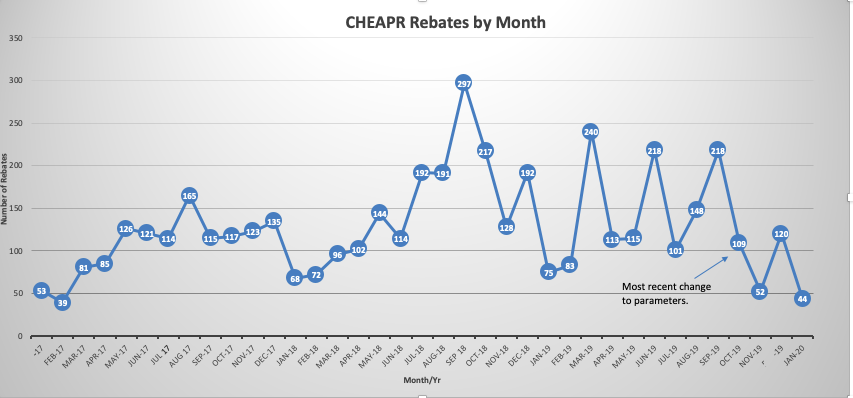Updated Track of CHEAPR Rebates – Data through 1/31/20
We have been keeping watch on rebate activity since the most recent change made to the CHEAPR rebate parameters, which lowered both incentives and price cap. The lower level of rebates continues as portrayed in the chart atop this post. The chart tracks the number of rebates by month from January 2017 (the program began in May 2015) through January 2020, which is the latest published data. CHEAPR usually updates their data about 4 weeks after the fact, so we are a few weeks from seeing February data. Although you don’t see it in the chart, the breakdown of rebates continues in its shift to PHEVs, which accounted for 57% of the rebates in January.
CHEAPR has posted an announcement on its website that they are reviewing the parameters and we should expect a change later this year. It is a very general update and we do not know what changes they are considering or when they will be implemented. The announcement also notes that they are looking into a rebate for used EVs, but again, no specifics.
The enabling legislation that was passed in 2019 established a $3 million annual allocation for CHEAPR beginning January 2020 through 2025 and authorized the development of the used EV incentive. The funds come from the clean-air surcharge on automobile registrations.
CHEAPR Structure
The other part of the announcement that we found interesting was that even though the program began in 2015, it had been considered to be a pilot all this time. Who knew! Now it has a more official status as noted in Public Act 19-117. As part of this structural modification, CHEAPR is getting a board of directors. This board is in the process of being filled. To our knowledge, there has only been one meeting so far this year. This nascent process seems to be part of the slow speed of change.
This organizational transition may cause delays in processing rebates.
This is a link to Public Act 19-117. It is a lengthy document and most of it has nothing to do with EVs. The part about CHEAPR begins on page 115.
Possible Data Conflict
The CHEAPR website shows rebate detail. If you toggle the slider, it reports 47 rebates for January. The website also offers an Excel file for download, which is what we used to create the chart. This file has two date fields: date of application and date of sale. We used the date of sale. Both numbers differ from the HTML feature. The date of application count is 57 and the date of sale count is 44. I guess that means your mileage will vary.
Run Rate
Based on the January data (and we would like to point out that there is a small difference in the data in the visual that is on the CHEAPR website and the Excel file that we downloaded to create the chart), the run-rate is about $500,000 annually. January has typically been a somewhat slow month for EV sales, generally speaking, but if the parameters are not revised, the allocated funds will not get spent.
There is one other factor to note that may indirectly affect rebate volume, which is that General Motors phases out of the federal tax credit as of March 31. There were 7 Chevy Bolt rebates in January. This car has been a tepid seller, to begin with, but losing the federal tax credit won’t help.
We eagerly await further news regarding their specific plans.

